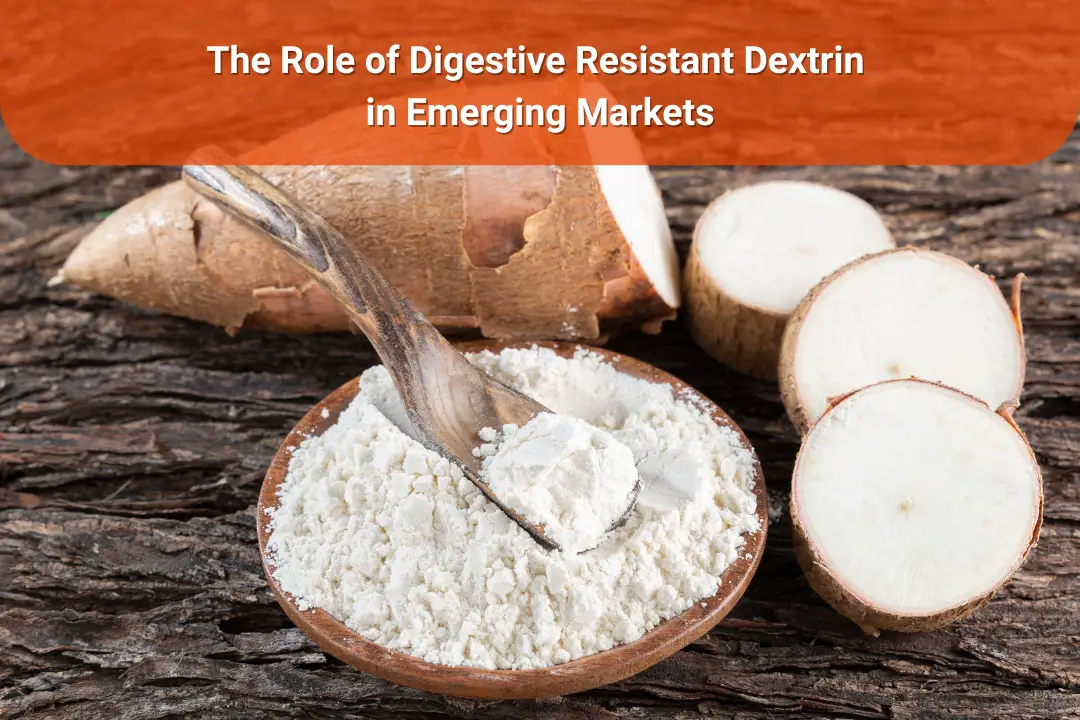The Role of Digestive Resistant Dextrin in Emerging Markets
May 15, 2025

In recent years, metabolic health issues such as obesity, diabetes, and metabolic syndrome have surged across emerging markets, creating a health and economic burden for millions. According to the World Health Organization, over 60% of the global diabetic population lives in low- and middle-income countries. These regions are undergoing rapid dietary and lifestyle shifts—more processed food, sedentary habits, and less fiber intake—exacerbating chronic diseases. As a result, there’s growing demand for science-backed nutritional interventions that are both affordable and adaptable to local diets. One such promising ingredient is digestive resistant dextrin (DRD). This article explores the role of digestive resistant dextrin in emerging markets, particularly in combating metabolic disorders.
Understanding Digestive Resistant Dextrin
Digestive resistant dextrin is a water-soluble dietary fiber produced from starch. It passes through the small intestine without being digested, reaching the colon where it is fermented by beneficial gut bacteria. Due to its chemical structure, DRD delivers unique health benefits, including blood sugar regulation, improved satiety, and gut health—key pillars in addressing metabolic disorders.
The Metabolic Health Crisis in Emerging Economies
Rising Health Concerns
Emerging markets, including Southeast Asia and Latin America, are seeing sharp increases in non-communicable diseases. Obesity rates in Latin America are projected to surpass 30% in several countries, while Southeast Asia is witnessing a quiet diabetes epidemic. Contributing factors include urbanization, fast food proliferation, and low-fiber diets.
Functional Ingredients as a Solution
Functional ingredients like resistant dextrin are gaining traction among health-conscious consumers and food manufacturers alike. These ingredients offer preventive benefits, supporting metabolic balance without requiring drastic dietary changes.
Digestive Resistant Dextrin as a Preventive Nutritional Tool
DRD supports metabolic health in multiple ways:
1. Blood Sugar Support
By slowing carbohydrate digestion and absorption, DRD helps reduce post-meal glucose spikes—essential for people with or at risk of type 2 diabetes.
2. Gut Health Enhancer
DRD is a fermentable fiber that supports beneficial bacteria, which in turn influence inflammation, insulin resistance, and even mood regulation.
3. Satiety Booster
One of DRD’s most valuable roles is its ability to increase feelings of fullness, thereby helping reduce calorie intake over time—a useful trait in managing obesity.
Fiber Gap in Traditional Diets
Despite traditional diets in emerging markets often being plant-based, modern lifestyles have significantly reduced daily fiber intake.
Hidden Opportunity
The average fiber consumption in Southeast Asia and Latin America is well below the WHO’s recommendation of 25-30 grams per day. This gap creates an opportunity for innovative products enriched with DRD that do not compromise taste or texture. DRD can be seamlessly added to common foods such as rice, soups, or beverages.
Blood Sugar Regulation and Glycemic Impact
Controlled Glycemic Response
Studies show that DRD can lower the glycemic index of carbohydrate-rich meals. This is especially beneficial for pre-diabetic and diabetic individuals trying to manage postprandial glucose levels.
Scientific Support
Clinical research supports DRD’s role in improving insulin sensitivity and lowering HbA1c over time when consumed regularly.
Satiety and Weight Management Applications
Appetite Regulation
By enhancing satiety, DRD can help individuals avoid overeating and manage their weight more effectively—key in countries experiencing obesity epidemics.
Real-World Benefits
Incorporating DRD into everyday snacks, shakes, or cereals can encourage calorie control without reducing satisfaction.
Prebiotic Effect and Gut-Metabolism Connection
The Gut-Metabolic Axis
Modern science increasingly points to the gut microbiota as a central player in metabolic health. DRD serves as a prebiotic, fostering the growth of beneficial bacteria like Bifidobacteria and Lactobacilli.
Holistic Benefits
These bacteria help regulate fat storage, enhance insulin sensitivity, and modulate inflammation—creating a ripple effect on metabolic conditions.
Ideal for Affordable Functional Foods and Beverages
Cost-Effective Innovation
DRD is a versatile ingredient suitable for a wide range of affordable food formats—ready-to-drink (RTD) beverages, cookies, soups, and instant noodles—all popular in emerging markets.
Scalable Solutions
Manufacturers can incorporate DRD into mass-market products, offering functional benefits without significant price increases.
Clean Label and Local Adaptation
Aligns with Consumer Trends
Consumers today prefer clean-label products—those with fewer, recognizable ingredients. DRD supports claims like “Plant-Based,” “No Sugar Added,” and “Gut Friendly.”
Culturally Sensitive Formulation
DRD can be added to local staples (e.g., rice, porridge, tea) without altering taste, helping brands align with cultural preferences and traditions.
Government and Healthcare Partnerships
Public Health Alignment
As governments tackle rising healthcare costs due to metabolic diseases, DRD-fortified products can align with public health campaigns.
Institutional Applications
Potential exists to include DRD in nutrition programs in schools, hospitals, and clinics, providing preventive support at the population level.
Addressing Consumer Education and Trust
Transparency and Awareness
In emerging markets, where skepticism toward functional claims may be higher, brands must invest in education. Highlighting clinical studies and using simple language about benefits like “blood sugar support” or “better digestion” builds trust.
Influencing Buying Decisions
Social proof, expert endorsements, and transparent labeling can drive adoption among consumers new to functional fibers.
A Strategic Ingredient for Health-Driven Product Innovation
Digestive resistant dextrin stands out as a powerful, research-backed solution to address the growing metabolic health crisis in emerging markets. Its multifaceted benefits—from blood sugar control and appetite regulation to gut health—make it an ideal addition to both mass-market and premium products. For manufacturers, DRD offers a unique value proposition: a low-cost, high-impact ingredient that aligns with consumer health trends, government initiatives, and global wellness goals.
At Satoria Nutrisentials, we recognize the transformative potential of functional ingredients like digestive resistant dextrin. Our commitment is to support innovation in affordable, effective, and culturally appropriate solutions for better health outcomes. Explore our product portfolio to discover how DRD can enhance your next formulation.